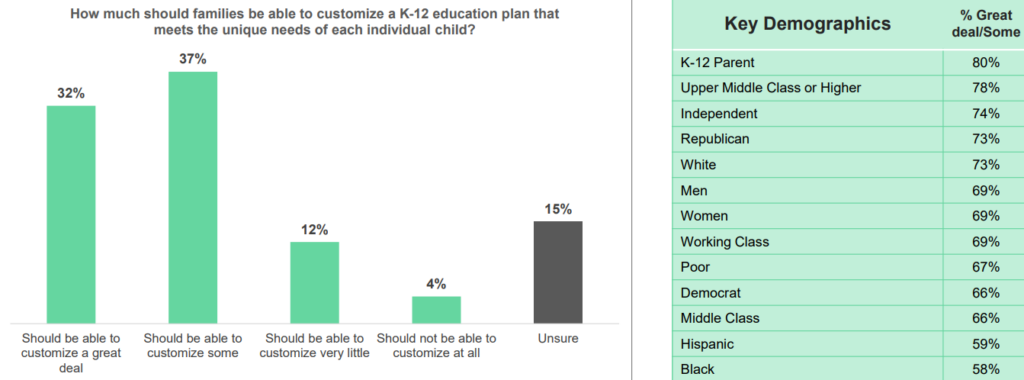Universal education savings accounts (ESAs) have truly changed the educational landscape across the nation. Today, 29 states offer some form of direct education funding to families and a dozen states empower every family to direct their child’s education dollars in ways that best meet their needs.
Families and school districts alike are seizing the opportunity to become a part of the coming transformation of education.
No Longer “Either-Or”
In a national survey, 80% of families said they want a customizable education experience for their child, but only 38% said they can currently do so. Education freedom policies like ESAs and tax credits can be a steppingstone for families to experience the level of personalization they crave.

Often, choice programs require families to opt out of their local district school (or public schools at large) to participate. Counterintuitively, some even require a student to be enrolled in public school at some point before opting to use an ESA. But some states have embraced the full vision of education freedom – a world transformed with options to meet every kid’s individual needs – by opening pathways for ESA students and public districts to collaborate.
Some districts are leading the way, offering opportunities for ESA families to utilize public schools for any manner of services previously only available to full-time enrolled students. These families want something different, and they are finding out that district schools can fulfill their needs as well.
Where It’s Happening
States like Utah, Florida, West Virginia, and Arizona with ESA programs allow students to use their funds for individual courses or extracurriculars offered by school districts.
For example, a June 2024 announcement from Canyons School District in Sandy, Utah, offered a glimpse into what this sort of flexibility can offer families from across the state.
“You’ve enrolled in a private school with no football team, marching band, or robotics program. You’re homeschooling and wanting hands-on exposure to engineering, woodworking, or drone aviation. Or, maybe you want to graduate early with online courses you complete at your own pace.
Look no further than Canyons School District, which is now approved to accept Utah Fits All Scholarships.”
Canyons School District provides a fee schedule for ESA families, accounting for quarter-credit to full-year classes, elementary school enrollment by the half-hour of annual instruction, tools like laptops, and access to activities like sports, art, music, and more.
Assembling a fee schedule that makes sense for both the district and families is critical. After all, this is a tool for districts to attract new students and new funds with them. Districts in these states are now in the position to make more resources available to more kids, advancing the mission of education for all.
In Florida, Brevard Public Schools led with their flourishing virtual school, assisted by a state program, to catalyze the collaboration needed to work with ESA families. Today, they are serving more students, expanding programs, retaining quality staff, and helping more local families because of their flexibility in accepting ESA funds.
Once districts start to build the “organizational muscles” of accepting ESA students’ funds – like a simple fee schedule – the benefits of taking the leap will begin to look clearer.
The Bottom Line
Education freedom isn’t about public vs. private; it’s about public and private–and how both options are working to meet the needs of families and students. District involvement in education freedom programs demonstrates the full reach and potential of direct-to-family funding programs like ESAs. One could imagine how a strong open enrollment policy could further benefit families and districts alike – broadening students’ access to courses and activities no matter their address.
For families who strongly value their local public schools and the flexibility of a more personalized education experience, this policy provision can be extremely beneficial. Once we recognize that every child may require something slightly different to meet their learning needs, the particular mode of education that they choose matters much less. District schools can be just as much a part of the solution.
Let’s think about even more ways how all types of education services can best reach those who need it. School district ESA partnerships are just the beginning of the transformation of education.
